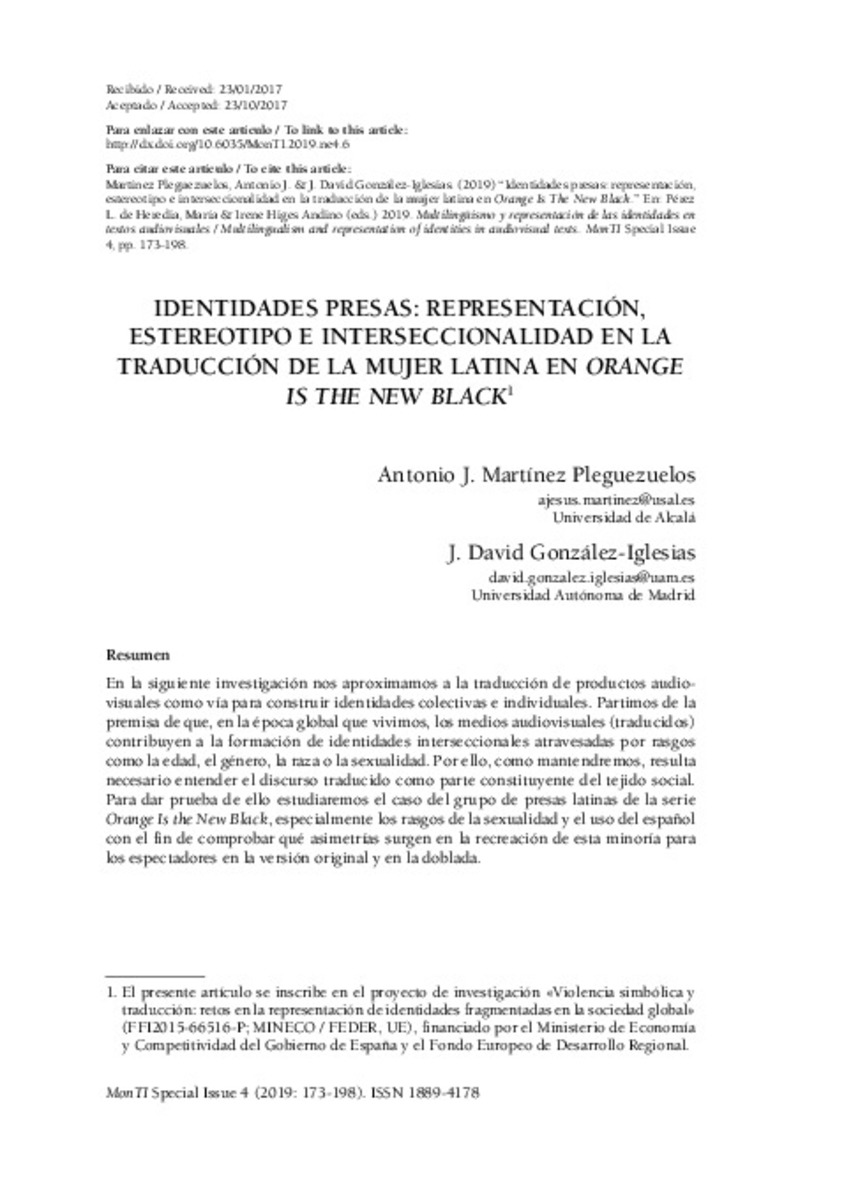Mostra el registre parcial de l'element
Identidades presas: representación, estereotipo e interseccionalidad en la traducción de la mujer latina en Orange Is The New Black
| dc.contributor.author | Martínez Pleguezuelos, Antonio J. | |
| dc.contributor.author | González-Iglesias, J. David | |
| dc.date.accessioned | 2019-10-24T07:07:19Z | |
| dc.date.available | 2019-10-24T07:07:19Z | |
| dc.date.issued | 2019 | |
| dc.identifier.citation | MARTÍNEZ PLEGUEZUELOS, Antonio J.; GONZÁLEZ-IGLESIAS, J. David. Identidades presas: representación, estereotipo e interseccionalidad en la traducción de la mujer latina en Orange Is The New Black. MonTI. Monografías de Traducción e Interpretación, 2019, núm. esp. 4, p. 173-198. | |
| dc.identifier.issn | 1889-4178 | |
| dc.identifier.issn | 1989-9335 (electrònic) | |
| dc.identifier.uri | http://hdl.handle.net/10234/184494 | |
| dc.description.abstract | In this study we approach the translation of audiovisual products as a way to construct collective and individual identities. We start from the premise that in the global era in which we live, (translated) audiovisual media contribute to the formation of intersectional identities characterized by features such as age, gender, race or sexuality. For this reason, it becomes necessary to understand translated discourse as an integral part of the social fabric. To support this statement, we study the case of the group of Latina inmates in the series Orange Is the New Black, particularly with regard to their sexuality and use of Spanish, in order to verify what asymmetries emerge from the re-creation of this minority for viewers in the original and dubbed versions of the series. | en_US |
| dc.description.abstract | En la siguiente investigación nos aproximamos a la traducción de productos audiovisuales como vía para construir identidades colectivas e individuales. Partimos de la premisa de que, en la época global que vivimos, los medios audiovisuales (traducidos) contribuyen a la formación de identidades interseccionales atravesadas por rasgos como la edad, el género, la raza o la sexualidad. Por ello, como mantendremos, resulta necesario entender el discurso traducido como parte constituyente del tejido social. Para dar prueba de ello estudiaremos el caso del grupo de presas latinas de la serie Orange Is the New Black, especialmente los rasgos de la sexualidad y el uso del español con el fin de comprobar qué asimetrías surgen en la recreación de esta minoría para los espectadores en la versión original y en la doblada. | es_ES |
| dc.format.extent | 173-198 | |
| dc.format.mimetype | application/pdf | |
| dc.language.iso | spa | |
| dc.publisher | Universitat Jaume I | |
| dc.publisher | Universitat de València | |
| dc.publisher | Universitat d' Alacant | |
| dc.relation.isPartOf | MonTI, 2019, núm. esp. 4 | |
| dc.rights.uri | http://creativecommons.org/licenses/by/4.0/ | * |
| dc.subject | Orange Is the New Black | |
| dc.subject | translation | |
| dc.subject | identity | |
| dc.subject | intersectionality | |
| dc.subject | Latina women | |
| dc.title | Identidades presas: representación, estereotipo e interseccionalidad en la traducción de la mujer latina en Orange Is The New Black | es_ES |
| dc.title.alternative | Prisoner Identities: Representation, Stereotype and Intersectionality in the Translation of the Latina Woman in Orange Is the New Black | en_US |
| dc.type | info:eu-repo/semantics/article | |
| dc.identifier.doi | 10.6035/MonTI.2019.ne4.6 | |
| dc.rights.accessRights | info:eu-repo/semantics/openAccess | |
| dc.relation.publisherVersion | http://www.e-revistes.uji.es/index.php/monti/article/view/4122 |
Fitxers en aquest element
Aquest element apareix en la col·lecció o col·leccions següent(s)
-
MonTi_ 2019 _núm.esp_4 [14]
Número especial 4








